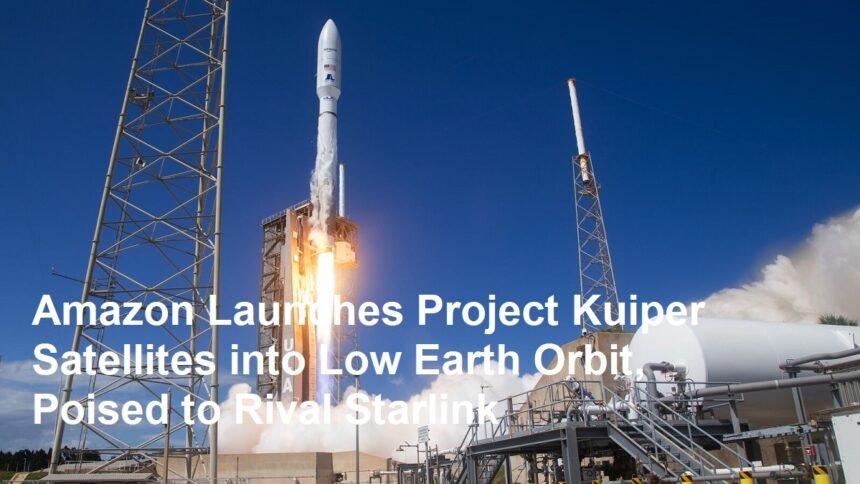Amazon has taken a major step into the satellite internet market by successfully launching the first batch of its Project Kuiper satellites into low Earth orbit (LEO). This milestone marks Amazon’s entry into the rapidly growing sector of space-based broadband services, positioning Project Kuiper as a strong competitor to SpaceX’s Starlink.
Overview of Project Kuiper
Project Kuiper is Amazon’s ambitious initiative to build a constellation of over 3,200 satellites designed to provide high-speed, low-latency internet access to underserved and remote areas around the world. The project aims to bridge the digital divide by delivering reliable broadband connectivity to millions of people who currently lack access to fast internet.
The first launch, conducted in late April 2025, successfully placed 60 satellites into orbit aboard a commercial rocket. These initial satellites will undergo testing and validation before Amazon begins deploying the full constellation.
Technical Details and Capabilities
Amazon’s Kuiper satellites operate in low Earth orbit, approximately 590 kilometers above the Earth’s surface. This proximity allows for reduced signal latency compared to traditional geostationary satellites, improving internet speed and responsiveness.
The satellites are equipped with advanced phased-array antennas and inter-satellite laser links, enabling efficient data transmission and network resilience. Amazon plans to leverage its extensive cloud computing infrastructure, including AWS (Amazon Web Services), to support the network’s backend operations and deliver seamless service.
Competition with Starlink
SpaceX’s Starlink currently dominates the satellite internet market, with over 3,000 operational satellites and millions of subscribers worldwide. Starlink has set the standard for LEO broadband services, offering high-speed internet to rural and remote customers in multiple countries.
Amazon’s Project Kuiper aims to challenge Starlink by focusing on several key differentiators:
- Integration with AWS: Amazon intends to integrate Kuiper’s satellite network with its cloud services, providing enhanced capabilities for enterprise customers and government agencies.
- Global Coverage: While Starlink has prioritized North America and parts of Europe, Kuiper plans to expand rapidly into underserved regions in Africa, Asia, and Latin America.
- Affordability and Accessibility: Amazon aims to offer competitive pricing and user-friendly equipment to attract a broad customer base, including low-income and rural communities.
Regulatory and Launch Milestones
Amazon received Federal Communications Commission (FCC) approval for Project Kuiper in 2020, with conditions to launch at least half of the satellites by 2026. The recent successful launch demonstrates Amazon’s commitment to meeting these regulatory milestones.
The company has partnered with multiple launch providers, including United Launch Alliance (ULA) and Arianespace, to ensure a steady cadence of satellite deployments. Future launches are planned throughout 2025 and beyond to build out the full constellation.
Market Potential and Challenges
The global satellite internet market is projected to grow significantly over the next decade, driven by increasing demand for connectivity in remote areas, disaster recovery, and mobile applications such as maritime and aviation internet.
Amazon’s entry intensifies competition, which could lead to improved services and lower prices for consumers. However, challenges remain:
- Space Debris and Congestion: The proliferation of LEO satellites raises concerns about space traffic management and collision risks.
- Technical Complexity: Building and maintaining a large satellite constellation requires advanced technology and significant investment.
- Regulatory Hurdles: Navigating international spectrum allocation and compliance with various countries’ regulations is complex.
Industry and Expert Reactions
Industry analysts view Amazon’s launch as a game-changer that could reshape the satellite internet landscape. The company’s vast resources, technological expertise, and global reach provide a strong foundation for Project Kuiper’s success.
SpaceX has acknowledged the increased competition but remains focused on expanding Starlink’s capabilities and customer base. Both companies are expected to drive innovation and accelerate the adoption of satellite broadband worldwide.
In summary, Amazon’s successful launch of Project Kuiper satellites marks a significant milestone in the satellite internet industry. By leveraging its technological strengths and global infrastructure, Amazon is poised to become a formidable competitor to Starlink, potentially transforming internet access for millions around the globe.









